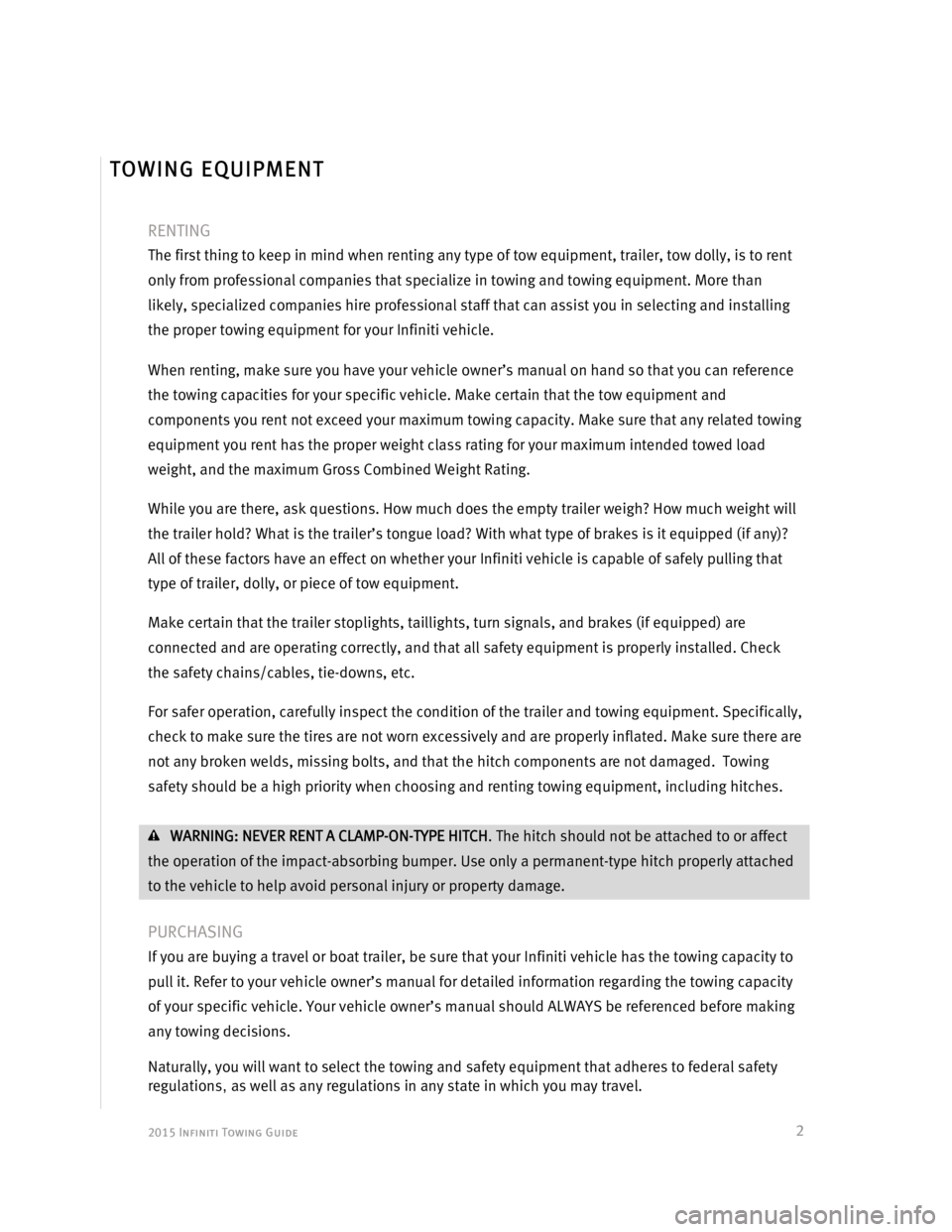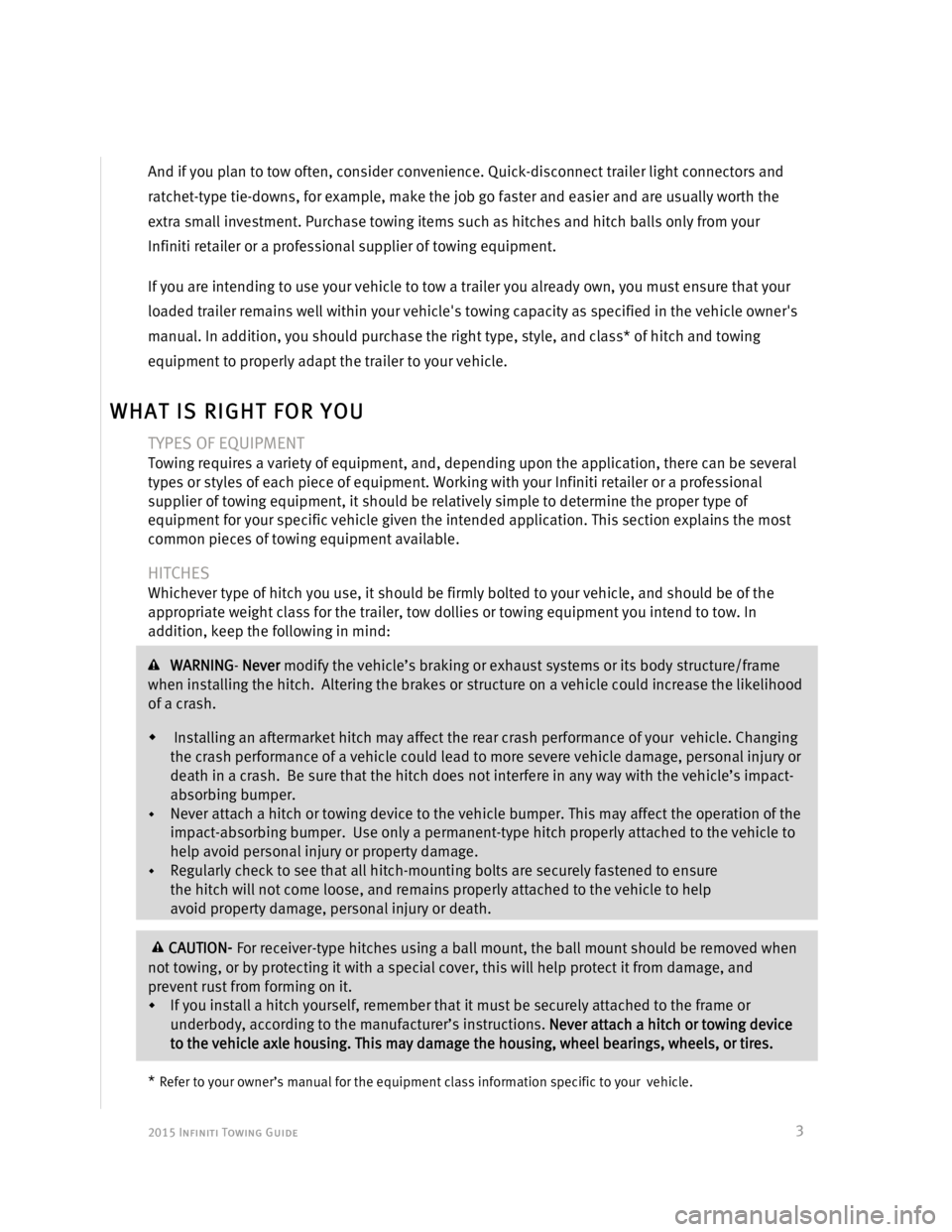ABS INFINITI Q70 2015 Towing Guide
[x] Cancel search | Manufacturer: INFINITI, Model Year: 2015, Model line: Q70, Model: INFINITI Q70 2015Pages: 25, PDF Size: 0.42 MB
Page 3 of 25

2015 Infiniti Towing Guide
2
RENTING
The first thing to keep in mind when renting any type of tow equipment, trailer, tow dolly, is to rent
only from professional companies that specialize in towing and towing equipment. More than
likely, specialized companies hire professional staff that can assist you in selecting and installing
the proper towing equipment for your Infiniti vehicle.
When renting, make sure you have your vehicle owner’s manual on hand so that you can reference
the towing capacities for your specific vehicle. Make certain that the tow equipment and
components you rent not exceed your maximum towing capacity. Make sure that any related towing
equipment you rent has the proper weight class rating for your maximum intended towed load
weight, and the maximum Gross Combined Weight Rating.
While you are there, ask questions. How much does the empty trailer weigh? How much weight will
the trailer hold? What is the trailer’s tongue load? With what type of brakes is it equipped (if any)?
All of these factors have an effect on whether your Infiniti vehicle is capable of safely pulling that
type of trailer, dolly, or piece of tow equipment.
Make certain that the trailer stoplights, taillights, turn signals, and brakes (if equipped) are
connected and are operating correctly, and that all safety equipment is properly installed. Check
the safety chains/cables, tie-downs, etc.
For safer operation, carefully inspect the condition of the trailer and towing equipment. Specifically,
check to make sure the tires are not worn excessively and are properly inflated. Make sure there are
not any broken welds, missing bolts, and that the hitch components are not damaged. Towing
safety should be a high priority when choosing and renting towing equipment, including hitches.
WARNING: NEVER RENT A CLAMP-ON-TYPE HITCH. The hitch should not be attached to or affect
the operation of the impact-absorbing bumper. Use only a permanent-type hitch properly attached
to the vehicle to help avoid personal injury or property damage.
PURCHASING
If you are buying a travel or boat trailer, be sure that your Infiniti vehicle has the towing capacity to
pull it. Refer to your vehicle owner’s manual for detailed information regarding the towing capacity
of your specific vehicle. Your vehicle owner’s manual should ALWAYS be referenced before making
any towing decisions.
Naturally, you will want to select the towing and safety equipment that adheres to federal safety
regulations, as well as any regulations in any state in which you may travel.
TOWING EQUIPMENT
Page 4 of 25

2015 Infiniti Towing Guide
3
And if you plan to tow often, consider convenience. Quick-disconnect trailer light connectors and
ratchet-type tie-downs, for example, make the job go faster and easier and are usually worth the
extra small investment. Purchase towing items such as hitches and hitch balls only from your
Infiniti retailer or a professional supplier of towing equipment.
If you are intending to use your vehicle to tow a trailer you already own, you must ensure that your
loaded trailer remains well within your vehicle's towing capacity as specified in the vehicle owner's
manual. In addition, you should purchase the right type, style, and class* of hitch and towing
equipment to properly adapt the trailer to your vehicle.
TYPES OF EQUIPMENT
Towing requires a variety of equipment, and, depending upon the application, there can be several
types or styles of each piece of equipment. Working with your Infiniti retailer or a professional
supplier of towing equipment, it should be relatively simple to determine the proper type of
equipment for your specific vehicle given the intended application. This section explains the most
common pieces of towing equipment available.
HITCHES
Whichever type of hitch you use, it should be firmly bolted to your vehicle, and should be of the
appropriate weight class for the trailer, tow dollies or towing equipment you intend to tow. In
addition, keep the following in mind:
WARNING- Never modify the vehicle’s braking or exhaust systems or its body structure/frame
when installing the hitch. Altering the brakes or structure on a vehicle could increase the likelihood
of a crash.
Installing an aftermarket hitch may affect the rear crash performance of your vehicle. Changing
the crash performance of a vehicle could lead to more severe vehicle damage, personal injury or
death in a crash. Be sure that the hitch does not interfere in any way with the vehicle’s impact-
absorbing bumper.
Never attach a hitch or towing device to the vehicle bumper. This may affect the operation of the
impact-absorbing bumper. Use only a permanent-type hitch properly attached to the vehicle to
help avoid personal injury or property damage.
Regularly check to see that all hitch-mounting bolts are securely fastened to ensure
the hitch will not come loose, and remains properly attached to the vehicle to help
avoid property damage, personal injury or death.
CAUTION- For receiver-type hitches using a ball mount, the ball mount should be removed when
not towing, or by protecting it with a special cover, this will help protect it from damage, and
prevent rust from forming on it.
If you install a hitch yourself, remember that it must be securely attached to the frame or
underbody, according to the manufacturer’s instructions. Never attach a hitch or towing device
to the vehicle axle housing. This may damage the housing, wheel bearings, wheels, or tires.
*
Refer to your owner’s manual for the equipment class information specific to your vehicle.
WHAT IS RIGHT FOR YOU